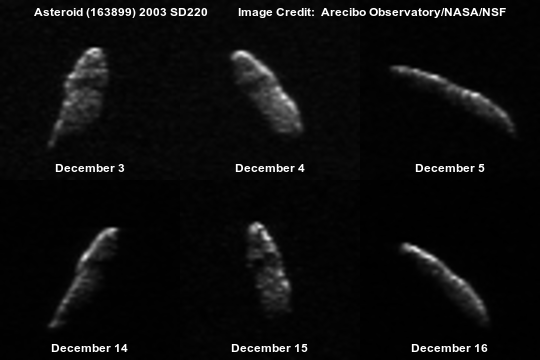Friday, December 25, 2015
The Christmas Eve Asteroid 2003 SD220 is Not Nibiru (and will not cause Earthqaukes)
Asteroid 2003 SD220, also known as the Christmas eve asteroid, will come close to Earth on 13:08 UT 24 December (that is 00:08 am AEDST in Australia) at distance of 0.073 AU. Visible only in high powered telescopes at closest approach, it has gained unwarranted attention from breathless articles in the tabloid press claiming that it could cause earthquakes (it won't, just like the other asteroids didn't). Various fringe sites have suggested it is, or is linked to, an imaginary planet called Nibiru (it''s not).
To put this in perspective, at its closest 2003 SD220 is around 28.4 Earth-Moon distances away this time. Yes, that is over 28 times the distance from the Earth to Moon (recall that the Apollo missions took 3 days to get to the Moon). As you can see from the image above, 2003 SD220 will only see the Earth and Moon as faint dots.
2003 SD220 is 1.8 kilometers in diameter (actually, it is quite elongated, image credit), too small and too far to have any gravitational effect on Earth. Consider that the Moon, orders of magnitude larger and 28 times closer, has negligible effects on earthqukaes, a 1.8 km dust mote is not going to have any effect. The asteroid comes close to us every couple of years or so, and hasn't had any effect in all the years it has passed us by.
As well, other large asteroids are being ignored favour of 2003 SD220. What about 2008 CM, a 1.5 km wide asteroid that will pass us by at 22 Earth-Moon distances on December 29. No one is claiming IT will cause earthquakes of is Nibiru.
So bottom line, 2003 SD220 will pass us by harmlessly, like all the other large asteroids we have been following.
For those of uswho just want to play around with the asteroid orbit, or who want to argue with people who claim this asteroid will hit us (it won't) I've made Celestia files for 2003 SD220. As usual, copy the data here to a plain text file (2003SD220.ssc) and copy the file to the Celestia extras folder.
========= >8 cut =============2003SD220.ssc=======>8; cut =====================
"2003 SD220" "Sol"
#Data from MPC http://cfa-www.harvard.edu/iau/MPEph/MPEph.html
#Epoch 2016 Jan. 13.0 TT = JDT 2457400.5 (M-h) MPC
#M 257.16312 (2000.0) P Q
#n 1.30903706 Peri. 326.44287 -0.48635381 +0.86135024 T = 2457479.05918 JDT
#a 0.8276272 Node 274.06174 -0.76583262 -0.50108247 q = 0.6533014
#e 0.2106332 Incl. 8.46007 -0.42066657 -0.08361889 Earth MOID = 0.01840 AU
#P 0.75 H 17.0 G 0.15 U 2
#From 217 observations at 8 oppositions, 2000-2015, mean residual 0".46.
{
Class "asteroid"
Mesh "ky26.cmod"
Texture "asteroid.jpg"
Radius 1.0 # maximum semi-axis
MeshCenter [ -0.000718 -0.000099 0.000556 ]
EllipticalOrbit
{
Epoch 2457400.5 # Epoch 2016 Jan. 13.0 TT = JDT 2457400.5
Period 0.893737187 # P
SemiMajorAxis 0.8276272 # a
Eccentricity 0.2106332 # e
Inclination 8.46007 # Incl.
AscendingNode 274.06174 # Node
ArgOfPericenter 326.44287 # Peri
PericenterDistance 0.6533014 # q
MeanAnomaly 257.16312 # M
}
RotationPeriod 11 #Measured
Albedo 0.15 #Based on typical Stony asteroids, rotation periods vary from one hour to one day
}
========= >8 cut =============2003SD220.ssc======= >8 cut===================== Labels: asteroids, celestia, earthquakes, Pseudoscience, public outreach
Comments:
<< Home
Question: If this were to strike, is there any way to tell approximately WHERE on earth it woul hit (land/ocean/continent)? Just curious.
Great blog by the way.
Post a Comment
Great blog by the way.
<< Home








 Click to read about or order
Click to read about or order Click to read about or order
Click to read about or order Click to read about or order
Click to read about or order Click to read about or order
Click to read about or order




